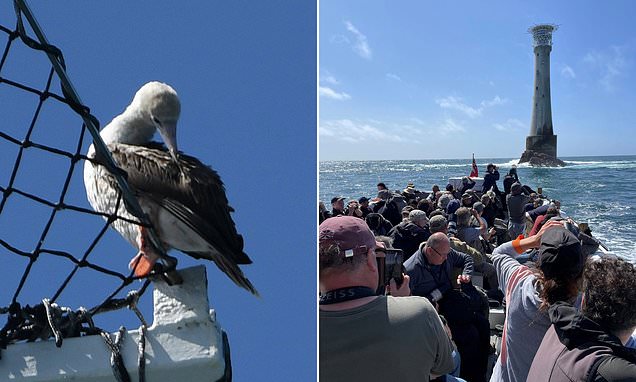Hundreds of birdwatchers flock to see rare ‘red-footed booby’ on the Isles of Scilly
- The rare bird was spotted for only the second time in UK waters off Cornwall
- Photos show around 400 birdwatchers cramming into boats to get a glimpse
Photos show hundreds of birdwatchers flocking to see a rare sea bird on a lighthouse off the British coast.
Pictures show ‘twitchers’ crammed into several small boats to catch a glimpse of the ‘red-footed booby’.
Bird-lovers have descended on the Isles of Scilly to see the booby – only once before spotted in UK waters.
The bird, which is native to the Galapagos islands, spends almost its entire life at sea and rarely travels outside of warm water zones.
However, it was spotted by a birdwatcher on patrol around the isolated Bishop Rock Lighthouse on August 7, 6.5km west of Scilly off Cornwall.
Birdwatches crammed into boats to catch a glimpse of the ‘red-footed booby’ off the Isles of Scilly
Since then, around 400 birdwatchers have dropped everything to see the bird, which appears to be resting before a return journey south.
Pictures captured by twitcher Ross Newham, 56, show birdwatchers in boats with binoculars on Sunday August 20.
Ross, from Larkfield, Kent, said: ‘There are lots of sea birds that spend all their time at sea, they’re called pelagic sea birds.
‘They only come to land when they breed, and so seeing a red-footed booby is incredibly rare.
‘The last time one was spotted in the UK, it was found in East Sussex and I think it had to be flown back to central America.
The rare bird is native to the Galapagos Islands and spends almost its entire life at sea. It’s only the second time one has been spotted in UK waters
‘Most rare sea birds are seen and gone within seconds or minutes – so the fact it’s been there for two weeks might mean it’ll spend the summer in our waters.
‘It may be injured or just fatigued from it’s long journey, but as it is a tropical species it won’t survive the winter – so we’re all hoping it’ll head home soon.
‘I had to wait six days to come and see it, but everyone really does just drop everything and go when these rare birds pop up. We all found out on social media and started making travel plans.
‘Part of the joy of the hobby is not knowing when you see friends who do same thing. You might not see them for two years – but then you get a sighting like this and it brings everyone together.’
Source: Read Full Article


